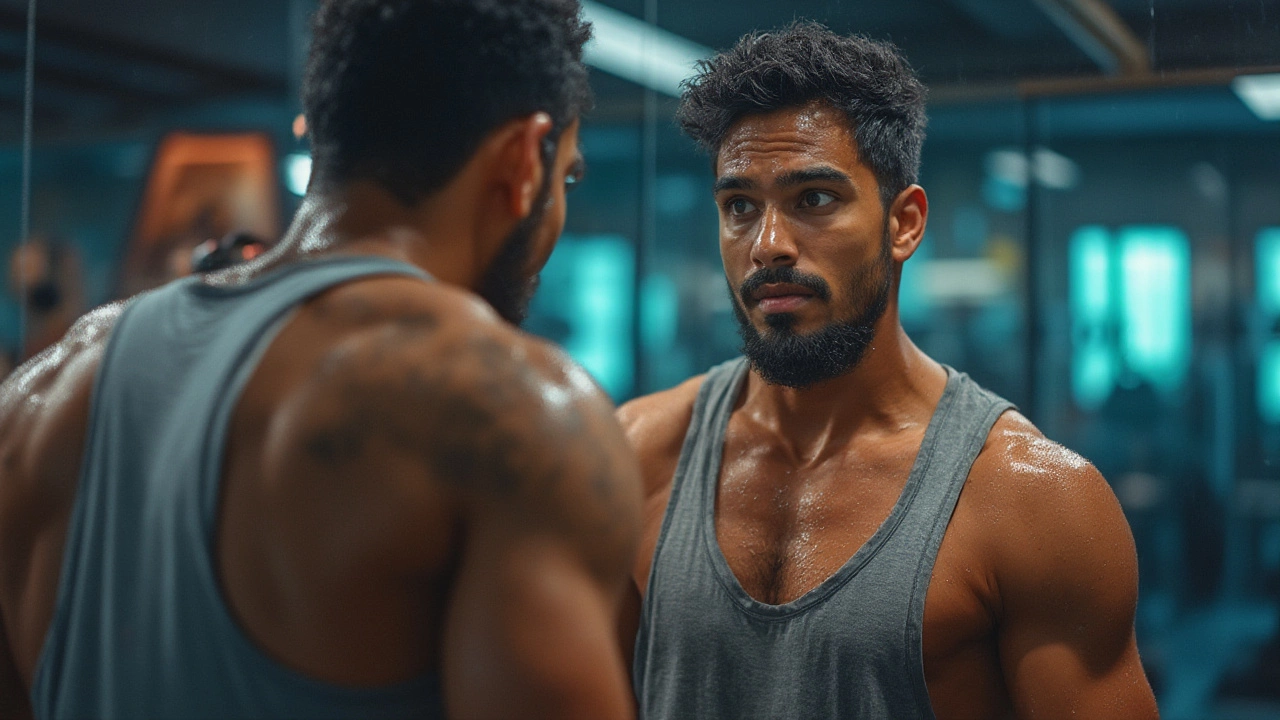HIIT Weight Gain: Surprising Reasons You Aren't Losing Weight with HIIT Workouts
 Jul, 18 2025
Jul, 18 2025
Imagine this: you finally swapped endless cardio for those sizzling HIIT sessions everyone on Instagram swears by. Sweat is practically dripping into your eyes during every burpee, you’re pushing harder than ever before—and yet, the scale creeps up. It’s enough to make anyone want to toss their jump rope across the room. It’s not just your imagination: people do sometimes gain weight after starting HIIT. And nope, it’s not always “just muscle.” Let’s get real about what might be going on and how you can make HIIT actually work in your favor.
When High-Intensity Isn’t Helping Your Scale (Yet)
It sounds backwards: High-Intensity Interval Training is famous for torching calories. It’s the “busy person’s fix” for fitness. But here’s a little-known side effect: HIIT can send numbers on a scale in the wrong direction if you’re not careful. This happens a lot and it isn’t some mystical calorie fairy sabotaging your results. A study from 2023 in the International Journal of Obesity highlighted that people, especially beginners, sometimes experience an initial weight gain with new high-intensity routines. Part of this is water retention. When you push your limits, muscles get tiny tears (it’s okay, this is how you grow stronger), which triggers inflammation so your body can repair the damage. Inflammation retains water. So for a week or two, your jeans might fit tighter even if your calorie deficit is real.
Your muscles themselves can also store a holiday supply of glycogen (the way our bodies stash usable carbs) for fast, explosive moves. Glycogen comes attached to water—around 3 grams of water for every gram of glycogen. After just a week of HIIT, your body could be holding onto two or three additional pounds of water weight. Ever notice how the scale jumps after a weekend of pizza and then drops after a week of clean eating? That’s mostly water playing tricks. Now, imagine loading your muscles with fresh glycogen to fuel all those HIIT sessions: the scale rises. It doesn’t mean you’re not making progress.
Still, water retention isn’t the whole story. Some weight gain is muscle, and that’s a good thing—muscle torches calories, even when you’re binging Netflix. But let’s be honest, unless you’re a total beginner, you won’t stack on pounds of muscle overnight, especially if you’re female. If you’re gaining a pound a week for a month, it’s not all brawn or water. Something else is at play.
The Surprising Downside of All-You-Can-Eat After HIIT
You know that wild hunger you get after a crazy-tough HIIT session? That’s not just in your head, unfortunately. Studies have proven intense interval workouts can send your appetite hormones on a rollercoaster. Ghrelin (the one that makes you hungry) tends to rise, while leptin (the “I’m full” hormone) tends to dip. I’ve totally raided my pantry after workouts, convincing myself I “earned” a second helping of peanut butter.
This is actually where a lot of HIIT-lovers mess up. We believe we’ve scorched 700 calories when the reality is usually closer to 250, unless you’re an elite athlete. Most smartwatches overshoot calorie burn estimates (mine once said I burned 450 calories in a 30-minute HIIT, which is generous, to say the least). If you eat back every calorie you think you burned, you could bust your deficit. And here’s something sneaky: the more you work out, the more efficient your body becomes, meaning you burn fewer calories to do the same thing. So, the burger you eat as a “reward” might cancel out all your hard work, or worse, tip you into a calorie surplus.
Some people actually end up eating more on their “rest days,” too, convinced that extra carbs are for “muscle recovery.” Meanwhile, if you’re sleep-deprived (common if you squeeze HIIT into your morning routine), your willpower tanks and cortisol rises. Higher cortisol = your body stores more fat, especially around your belly. Ever walk into the kitchen for a healthy snack and find your hand in the chips bag instead? There’s science behind this. With more intense exercise, your hunger could outweigh your willpower, especially if HIIT is new for you.

Stress, Sleep, and Sneaky Body Reactions
We don’t talk enough about the impact of stress. HIIT is a stressor—and not just for your muscles. Exercising at this intensity jacks up cortisol temporarily, but for some people, if you don’t manage stress in other parts of your life, it turns chronic. Constantly elevated cortisol leads to stubborn fat gain, often right in the belly. There was a 2022 study in “Stress & Health” that found people who paired intense exercise with poor sleep or job stress actually gained abdominal fat, not just weight overall.
Sleep matters way more than people realize, too. Bad sleep, or not enough of it, throws your metabolism into chaos. It also kills muscle recovery. When you short-change sleep after all that high-intensity effort, your body freaks out, raising appetite hormones and lowering your desire to do anything (like prep a salad instead of ordering in). On bad nights, you might even subconsciously move less during the day—taking elevators instead of stairs, slumping on the sofa instead of doing that bonus dog walk with Charlie. That lack of “non-exercise activity” is an under-the-radar culprit in sneaky weight gain.
Your body might also respond to the stress of HIIT by holding onto fat as a survival tactic. Especially if you’re cutting calories hard, your metabolism slows down to protect your energy stores. This is why, weirdly enough, eating more and dialing down stress can restart your progress. Real life example: I once plateaued hard for a month during a HIIT challenge, until I swapped three sessions for extra sleep and made friends with sweet potatoes again. The scale started dropping—go figure.
Common HIIT Mistakes That Make Weight Loss Harder
No shame here—almost nobody gets HIIT “perfect” right away. Probably the most common mistake is doubling up on HIIT and then skipping lifting or longer low-intensity cardio, thinking “short and hard” is enough. But HIIT isn’t magic. If you only do high-intensity, your workout variety plummets, your joints can get cranky, and your muscles stop getting new challenges. Constant repetition can also trigger what’s called “adrenal fatigue” (not recognized by all doctors but very real for a lot of people), which just means your energy tanks and your motivation crumbles.
Another misstep: Not tracking actual food intake. Apps like MyFitnessPal or Cronometer make it way too easy—most of us are eating more than we think, whether it’s that handful of trail mix or bites off our kid’s plate. Even healthy foods have calories! If you really want to lose weight, write down every sip and nibble, even for a week as a reality check.
Also, beware of the mindset that HIIT is an excuse to skip recovery days. Your muscles desperately need time off to repair, actually grow, and burn fat efficiently. Overtraining not only ramps up your risk of injury but also keeps cortisol high and fat loss stuck. There’s an old fitness coach trick: If you have trouble sleeping or your heart rate stays high at rest, you’re probably overdoing it.
And here’s one last secret saboteur—post-workout you. Lots of us become “couch potatoes” the rest of the day after HIIT, subconsciously resting because you “worked so hard.” So what happens? You actually burn fewer total calories that day than you think, because all your other movement slows down. Try wearing a step tracker one day and check your step count after a HIIT session. It might surprise you!

Smart Fixes For HIIT-Related Weight Gain
Here’s the good news: It’s totally fixable, often with just a few tweaks. First, if you’re new to HIIT, give yourself 2–3 weeks for water to stabilize. Don’t panic if the scale bumps up, especially if you’re seeing gains in endurance or muscle definition.
Make sure you track what you eat—even if you just snap pics on your phone. Portion sizes matter, even after a killer sweat fest. You don’t need to starve, but aim for a modest calorie deficit: 300-500 calories per day is enough for most adults. If you find yourself ravenous after HIIT, try eating more protein and fiber throughout the day. They keep you full and calm blood sugar swings, so you’re less likely to inhale a bag of pretzels at 5pm.
Add some extra low-impact movement on HIIT days—a 20-minute easy dog walk (Charlie loves this trick), a light yoga session, or standing up to stretch while you’re on the phone. These gentle activities help flush out inflammation and make sure you move enough to keep burning calories even after your workout.
Always prioritize sleep. Set a bedtime alarm if you need to. Blackout curtains, white noise, a phone-free bedroom: whatever it takes to clock those precious 7-8 hours. Try scheduling HIIT for days when you don’t have extra stress at work or home, and weave in recovery days—stretching, foam rolling, or just relaxing with your pet counts.
If you keep gaining weight despite these tweaks, check your workout mix. Trade a few HIIT sessions for slower strength training or a gentle hike. Sometimes less is more. And if you’re still stuck, get bloodwork done—thyroid issues, vitamin D deficiency, or hormonal fluctuations can sabotage your efforts, and they’re more common than you think.
Finally, be kind to yourself. HIIT is supposed to make you feel strong and energized, not just chase a lower number on the scale. The body changes you want often show up a few weeks after the habit sticks. And your dog won’t love you less if you take a week off for self-care.
So the next time the scale bumps up after a week of HIIT heroics, don’t panic or quit. Step back, get real about what’s going on, and make a few smart changes. Your results will catch up—and you’ll actually enjoy the process along the way.
